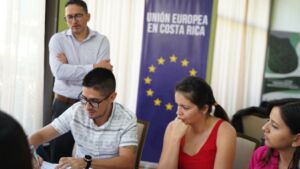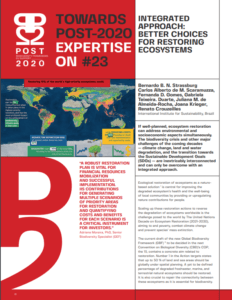Within the framework of the support given by the European Union to countries to meet the goals of the Kunming-Montreal Global Biodiversity Framework, the National Conservation Areas System of Costa Rica (SINAC) is leading a process to establish priorities for the implementation of the national strategy for ecosystem restoration.
Building upon a previous work in which preliminary criteria were identified, a workshop was held late February 2023 with experts to discuss and agreed upon prioritization criteria for landscape restoration at national level. The workshop also provided the opportunity to reflect on governance models to ensure a greater coordination and efficiency of ecosystems restoration efforts undertaken by Costa Rican public and private institutions.
In prioritized sites, the National System of Conservation Areas (SINAC) intends to implement different strategies of regeneration, recovery, rehabilitation, reforestation and restoration (5Rs) as defined in the National Strategy for Landscape Restoration in Costa Rica, 2021 – 2050 aiming at promoting an integrated landscapes management in harmony with the productive sectors.

Participants of the workshop. © Daniel Murillo
The workshop was attended by Local Governments from San José, Santa Ana and La Unión but also NGOs such as Panthera, Tropical Studies Organization, Raising Coral and International Conservation.
Several international organizations leading cooperation projects linked to land conservation processes also participated, among which UNDP’s “Project: towards an urban green economy”, GIZ‘s EBALAC Program, and the “Policy-based budget support program to implement the sustainable trajectory and Inclusive of Costa Rica” by Expertise France.
Members of the academic sector also participated including CIMAR-UCR, CATIE, CENAT and the Costa Rican National Museum.
Jaqueline Vargas, from San José Municipality, Urban Development Department mentioned that “This guide we are working on with SINAC and the Post 2020 Biodiversity Framework – EU Support project is really important for the development of “Lands Regulation Plans” done by the municipality to localize in which spaces we will intervene in order to have a “greener” and more sustainable San José. It will require work from the municipality but also from strategic allies that were present at the workshop”.
Building on the not less important participation of the civil society in the process, the Panthera Asociation NGO Director, Roberto Salom Pérez, explained the significance for his organization to select criteria for establishing restoration priorities because “(…) “As an NGO, this work will give us tools to align our efforts on restoration with the country and international priorities and to see which biodiversity information that we generate can feed national indicators.”
The Knowledge and Capacity Building Coordinator of the Post 2020 Biodiversity Framework – EU Support project, Nicolas Thomas, pointed out that “By identifying most relevant criteria to prioritize areas for restauration in urban, rural and marine landscapes, Costa Rica is making a crucial step towards the implementation of the newly adopted Kunming-Montreal Global Biodiversity Framework and its Target 2.”
Additional workshop and consultations will be further organized in the upcoming months to complete the methodology for identifying ecosystems restoration priorities in Costa Rica and its application at national scale. Meanwhile, SINAC with the support of the project also continues to focus on updating the marine and coastal conservation gap analysis. A draft scenario proposal to identify conservation gaps will be presented in the coming weeks.
Read our relevant 4 pagers:


